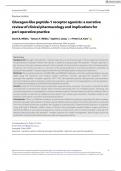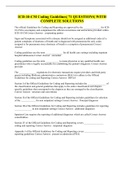Anaesthesia 2024 doi:10.1111/anae.16306
Review Article
Glucagon-like peptide-1 receptor agonists: a narrative
review of clinical pharmacology and implications for
peri-operative practice
David A. Milder,1 Tamara Y. Milder,2 Sophie S. Liang1 and Peter C.A. Kam3
1 Department of Anaesthesia, Westmead Hospital, Westmead, NSW, Australia
2 Department of Diabetes and Endocrinology, St. Vincent’s Hospital, Darlinghurst, NSW, Australia
3 Discipline of Anaesthesia, Faculty of Medicine and Health, University of Sydney, Sydney, NSW, Australia
Summary
Background Glucagon-like peptide-1 receptor agonists are used increasingly in the management of patients
living with type 2 diabetes mellitus and obesity. In patients using glucagon-like peptide-1 receptor agonists, a
key concern in the peri-operative period is the increased risk of pulmonary aspiration due to delayed gastric
emptying. This review provides an overview of the pharmacodynamic and pharmacokinetic properties of
glucagon-like peptide-1 receptor agonists and the risk of delayed gastric emptying and aspiration.
Methods We conducted searches of MEDLINE and EMBASE databases of articles published before January
2024 using the keywords and medical subject headings: incretins; glucagon-like peptide-1; GLP-1;
glucagon-like peptide-1 receptor agonists; GLP-1 RA; peri-operative period; perioperative; peri-operative;
stomach emptying; gastric emptying; pulmonary aspiration; aspiration; food regurgitation; and regurgitation.
The evidence was analysed, synthesised and reported narratively.
Results A total of 1213 articles were located after duplicates were removed. Two authors screened the titles
and abstracts to identify those studies which assessed specifically the risk of delayed gastric emptying and
pulmonary aspiration or regurgitation in the peri-operative period. We searched manually the reference lists of
relevant studies to identify any additional case reports. Ten studies were identified. Available evidence was
limited to case reports, case series and observational work.
Conclusions There is insufficient evidence to put forward definitive guidance regarding the ideal cessation
period for glucagon-like peptide-1 receptor agonists before elective surgery. Precautionary practice is required
until more evidence becomes available. We suggest an individualised, evidence-based approach. In patients
living with type 2 diabetes mellitus, there is concern that prolonged cessation before surgery will have a
detrimental effect on peri-operative glycaemic control and discussion with an endocrinologist is advised. For
patients taking glucagon-like peptide-1 receptor agonists for weight management, these drugs should be
withheld for at least three half-lives before an elective surgical procedure.
.................................................................................................................................................................
Correspondence to: Peter C.A. Kam
Email: peter.kam@sydney.edu.au
Accepted: 2 April 2024
Keywords: aspiration; gastric emptying; glucagon-like peptide-1 agonists; peri-operative guidelines
© 2024 The Authors. Anaesthesia published by John Wiley & Sons Ltd on behalf of Association of Anaesthetists. 1
This is an open access article under the terms of the Creative Commons Attribution-NonCommercial-NoDerivs License, which permits use and
distribution in any medium, provided the original work is properly cited, the use is non-commercial and no modifications or adaptations are made.
, 13652044, 0, Downloaded from https://associationofanaesthetists-publications.onlinelibrary.wiley.com/doi/10.1111/anae.16306 by Cochrane Saudi Arabia, Wiley Online Library on [20/05/2024]. See the Terms and Conditions (https://onlinelibrary.wiley.com/terms-and-conditions) on Wiley Online Library for rules of use; OA articles are governed by the applicable Creative Commons License
Anaesthesia 2024 Milder et al. | Peri-operative glucagon-like peptide-1 agonists
Introduction evidence on gastric emptying in the context of type 1
Glucagon-like peptide-1 (GLP-1) receptor agonists are a diabetes mellitus is even more limited, this narrative review
class of medications prescribed to patients living with type 2 is specific to patients with type 2 diabetes mellitus.
diabetes mellitus and obesity. These drugs are appropriate
in the early treatment of type 2 diabetes mellitus, especially Methods
for those with obesity, and/or those at high risk for We conducted searches of MEDLINE and EMBASE
atherosclerotic cardiovascular disease, heart failure or databases using the keywords and medical subject
chronic kidney disease. They are effective in lowering headings: incretins; glucagon-like peptide 1; GLP-1;
fasting plasma glucose and glycated haemoglobin in glucagon-like peptide 1 receptor agonists; GLP-1 RA;
patients living with type 2 diabetes mellitus. These drugs are peri-operative period; perioperative; peri-operative;
considered to have a low risk of hypoglycaemia with no stomach emptying; gastric emptying; pulmonary aspiration;
clinically significant difference in hypoglycaemic events aspiration; food regurgitation; and regurgitation. These
among drugs within the class. They have shown efficacy in subject headings and keywords were combined with
clinical trials to promote weight loss by delaying gastric ``AND/OR´´ Boolean operators. The search was limited to
emptying and increasing satiety, in patients with and English full-text articles and human subjects published before
without and diabetes mellitus [1]. the end of January 2024. Two reviewers (DM and PK)
In the peri-operative period, there are concerns that the screened the titles and abstracts to identify those studies
use of GLP-1 receptor agonists is associated with an which assessed specifically the risk of delayed gastric
increased risk of bronchopulmonary aspiration due to emptying and pulmonary aspiration or regurgitation in the
retained gastric contents. There is insufficient evidence peri-operative period. We searched manually the reference
currently to guide anaesthetists to mitigate against this risk. lists of relevant studies to identify any additional case reports.
Until recently, peri-operative guidelines and reviews on
GLP-1 receptor agonists did not recommend cessation of Results
these medications before surgery. In 2021, Hulst et al. A total of 1213 articles were identified after duplicates were
recommended continuing all GLP-1 receptor agonists removed. In total, 10 studies were identified. Available
throughout the peri-operative period and noted only evidence was limited to case reports, case series and
theoretical adverse effects such as delayed gastric observational work. Where possible, identified studies are
emptying and postoperative nausea and vomiting [2]. In a grouped into clinically relevant themes.
recent narrative review on the peri-operative management
of patients with diabetes mellitus, Crowley et al. Physiology
recommended continuing GLP-1 receptor agonists on the The `incretin effect´ of GLP-1 receptor agonists was first
day of surgery [3]. However, these recommendations have described when an oral glucose load was shown to produce
since been challenged, with emerging case reports of a proportionally greater and sustained release of insulin
regurgitation or aspiration during general anaesthesia [4– compared with an equivalent dose of intravenous glucose
7], endoscopic evidence of retained solids or liquids [8–10] [12, 13]. The incretin effect, which contributes to two-thirds
and gastric ultrasonography showing retained solids in of total insulin secretion in response to an oral glucose load,
patients prescribed GLP-1 receptor agonists [11]. is blunted in individuals with type 2 diabetes mellitus.
In this narrative review, we explore the diverse clinical Glucagon-like peptide-1 is a proglucagon cleavage product
effects of GLP-1 receptor agonists with a focus on their released by L-enteroendocrine cells in the terminal ileum
gastrointestinal effects and the associated peri-operative and proximal colon in response to a glucose load and
implications. These drugs are associated with an increased triglycerides [14, 15]. Glucagon-like peptide-1 is also
risk of gastric stasis and aspiration or regurgitation in the secreted by a islet cells and neurons located in the nucleus
peri-operative period. However, there is currently tractus solitarius in the brainstem [16]. It is cleaved rapidly
insufficient evidence to guide the minimum cessation by dipeptidyl peptidase-4 into GLP-1 (9–36) amide and
period required for these drugs. This is further complicated eliminated by the kidneys, resulting in a short half-life of
by the risk of worsening glycaemic control if these drugs are approximately 2 min [17].
not administered for a prolonged duration. Recently, GLP-1 When the G-protein coupled GLP-1 receptor is
receptor agonists have also been prescribed off-label for activated, intracellular calcium is increased in the islet b cells
patients living with type 1 diabetes mellitus. Given the leading to exocytosis of insulin. In islet a cells, glucagon
2 © 2024 The Authors. Anaesthesia published by John Wiley & Sons Ltd on behalf of Association of Anaesthetists.





